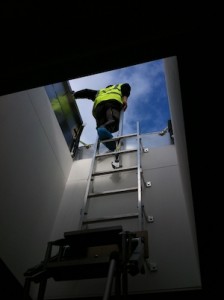View the Bilco UK entry on BPindex
Tony Stevens, Technical Estimator at Bilco UK, outlines some of the key factors to be considered when specifying ladders for accessing a roof area.
Where is the ladder going to be used?
If the ladder is required to gain access to the roof and to be mounted externally it will require a safety cage and guard rail to enter the roof safely.
What is the ladder going to be used with?
You need to have a clear understanding of the type of access product the ladder is going to be used with.
For a small hatch, such as the Bilco E-50TB, which has internal dimensions of 915mm x 915mm, a fixed vertical ladder should be specified. A retractable ladder would not be recommended for the E-50TB as the ladder angle would hinder access when you get close to the hatch.
 Where frequent access to the roof area is required for maintenance personnel, tools and equipment a companionway roof hatch, like the CS-50TB which is a larger elongated access hatch, is generally required. In this instance a companionway ladder or a retractable ladder can be specified (the maximum size for companionway would be 2440mm and 1500mm for retractable).
Where frequent access to the roof area is required for maintenance personnel, tools and equipment a companionway roof hatch, like the CS-50TB which is a larger elongated access hatch, is generally required. In this instance a companionway ladder or a retractable ladder can be specified (the maximum size for companionway would be 2440mm and 1500mm for retractable).
The companionway ladder is a 75 degree angled, rigid ladder providing permanent access to the roof hatch.
Retractable ladders are ideal for use in areas, such as schools and hospitals, where the floor space must be kept clear. They can be mounted above a ceiling and be offered with additional vertical backboards with steps and a handrail. They can also be supplied with fire rating.
Where access is required to the roof area via a smoke ventilator, like the Bilco ESW-50REM, a retractable ladder is not an option. The very nature of the mechanism of a retractable ladder would prevent the flow of smoke through the vent. It would therefore be counterproductive to use a retractable ladder with a smoke vent, although we have seen this specified on more than one occasion!
The only recommended ladder for use with a smoke ventilator is a fixed vertical ladder, due to the small footprint of this type of ladder.
Ladder Height
Knowing the height of the floor to underside of roof access hatch that you wish to access may seem incredibly obvious, but you may be surprised by the number of ladders that are specified either too short or too long for the height required!
Roof Void Height
When specifying a retractable ladder it is essential that you know the height of the roof void – the space between the ceiling and the roof. This is to ensure the ladder box liner will fit inside the space once retracted.
What happens if you get the specification wrong?
If you specify a small hatch for use with either a companionway ladder or retractable ladder it will be difficult to access, so it will not be functional.
If you specify a large length hatch, it will be difficult to access from a fixed vertical ladder. The worker will have to overstretch to open and close the hatch, putting themselves into an unsafe position.
If you specify a retractable ladder with a smoke ventilator you will compromise the integrity of the smoke ventilator by blocking the flow of smoke.
To conclude, specifying ladders might seem like a straightforward aspect of a building project but the health and safety and functionality implications are far reaching. Always ensure you specify the right type of ladder and hatch that will provide the safest and easiest access to the roof area.
If you need some help with specifying the right ladder to use for roof access please contact Tony – tony.stevens@access-360.co.uk.

